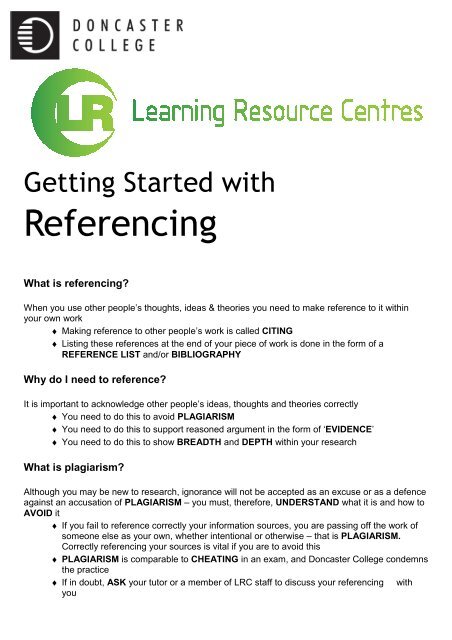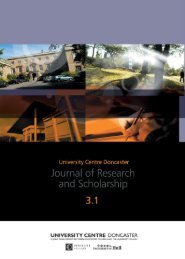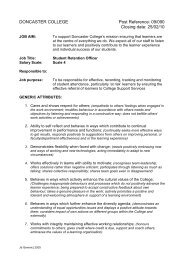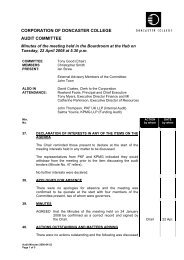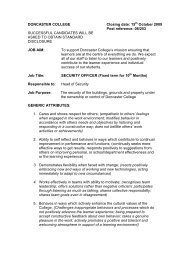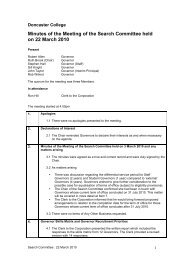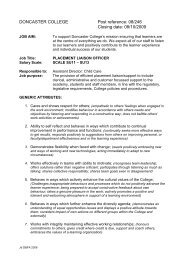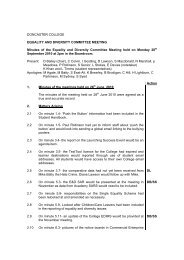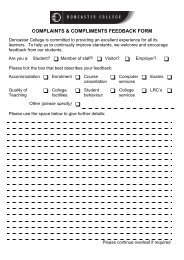Getting started with referencing.pub - Doncaster College
Getting started with referencing.pub - Doncaster College
Getting started with referencing.pub - Doncaster College
Create successful ePaper yourself
Turn your PDF publications into a flip-book with our unique Google optimized e-Paper software.
<strong>Getting</strong> Started <strong>with</strong>ReferencingWhat is <strong>referencing</strong>?When you use other people’s thoughts, ideas & theories you need to make reference to it <strong>with</strong>inyour own work♦ Making reference to other people’s work is called CITING♦ Listing these references at the end of your piece of work is done in the form of aREFERENCE LIST and/or BIBLIOGRAPHYWhy do I need to reference?It is important to acknowledge other people’s ideas, thoughts and theories correctly♦ You need to do this to avoid PLAGIARISM♦ You need to do this to support reasoned argument in the form of ‘EVIDENCE’♦ You need to do this to show BREADTH and DEPTH <strong>with</strong>in your researchWhat is plagiarism?Although you may be new to research, ignorance will not be accepted as an excuse or as a defenceagainst an accusation of PLAGIARISM – you must, therefore, UNDERSTAND what it is and how toAVOID it♦ If you fail to reference correctly your information sources, you are passing off the work ofsomeone else as your own, whether intentional or otherwise – that is PLAGIARISM.Correctly <strong>referencing</strong> your sources is vital if you are to avoid this♦ PLAGIARISM is comparable to CHEATING in an exam, and <strong>Doncaster</strong> <strong>College</strong> condemnsthe practice♦ If in doubt, ASK your tutor or a member of LRC staff to discuss your <strong>referencing</strong> <strong>with</strong>you
Get StartedThere are a variety of <strong>referencing</strong> formats that you can use. At <strong>Doncaster</strong> <strong>College</strong> we use theHarvard Referencing format to create references.This is a brief guide to Harvard Referencing; a full and comprehensive guide is available on theLRCs’ e-Library.Book <strong>with</strong> 1 AuthorFormat:Author Surname, Initial. (year of <strong>pub</strong>lication) Title: subtitle. Edition if not 1 st . City / town of<strong>pub</strong>lication: PublisherNotes:♦ Within the reference, the book title should be italicised♦ Place of <strong>pub</strong>lication is always the city/town not the country i.e. London, not UK♦ The year is the date of <strong>pub</strong>lication, not a reprint date. Look out for these on the verso(back of the title page), they have no bearing on edition dates♦ Anything other than a 1 st edition e.g. 2 nd , 3 rd , 4 th etc., needs to be included <strong>with</strong>in thereference, and goes immediately after the titleReference Example:Evans, M. (2004) How to pass exams every time. 2nd edition. Oxford: How To Books.Citation:Citation <strong>with</strong>in text:Evans (2004) provides a variety of checklists to help students do well in their exams.Citation <strong>with</strong> quote:According to Evans (2004) “one of the greatest barriers to success is your attitude” (p. 1).Citation notes:♦ You need to include the page number for a direct quote♦ When quoting directly, “quotation marks” are used to distinguish a short quotation, usuallyno more than 2 lines in length♦ Longer quotations should be indented and placed in a separate paragraph, you do notneed quotation marks as well
Book <strong>with</strong> 2 AuthorsFormat:Author Surname, Initial and Author Surname, Initial. (year of <strong>pub</strong>lication) Title: subtitle. Edition if not1st. City / town of <strong>pub</strong>lication: PublisherNotes:♦ Where there are 2 authors, the order of the author’s name should be retainedReference example:Crolley, L. and Hand, D. (2002). Football, Europe and the Press. London: Frank Cass.Citation <strong>with</strong>in text:Crolley and Hand (2002) argue that the nature of the British press is to portray English footballsupporters as soldiers fighting for a cause, rather than spectators.Citation <strong>with</strong> quote:When discussing the issue of the British press, it could be argued that “foreigners are quite simplyportrayed in a negative light throughout the British press” (Crolley and Hand, 2002, p. 24)Citation notes:♦ When citing or quoting directly from a book by 2 authors, both surnames appear in the texttogether <strong>with</strong> the year of <strong>pub</strong>licationBook <strong>with</strong> many AuthorsFormat:Author1 Surname, Initial., Author2 Surname, Initial. and Author3 Surname, Initial. (year of<strong>pub</strong>lication) Title: subtitle. Edition if not 1st. City / town of <strong>pub</strong>lication: PublisherNotes:♦ The reference should contain all the authors’ names♦ The order of the authors’ surnames should be retainedReference example:Morris, S., Willcocks, G, and Knasel, E. (2002) How to lead a winning team. London: Prentice-HallCitation <strong>with</strong>in text:As demonstrated by Morris et al. (2002) leadership should concern everyone <strong>with</strong>in an organisation,not just senior managementCitation <strong>with</strong> quote:Listening is a skill which all leaders should acquire. Morris et al. (2002) believe that:showing that you want to listen is one of the things you can do quickly to change the wayyour department feels and to develop strong bonds between you and your colleagues (p. 39).Citation notes:♦ When referring to the book <strong>with</strong>in the text (citing), et al. is used. It literally means “andothers”. You are only required to put the first named author followed by et al.♦ The convention is italicise et al. followed by a full stop
Journal ArticleFormat:Author Surname, Initial. (year of <strong>pub</strong>lication) Title of article: subtitle. Journal Title, Volume(Number), pagesNotes:♦ The name of the journal is italicised, not the title of the article♦ The volume number is in bold♦ Volume part numbers may be replaced by a month or date♦ Page numbers for journal articles are included in the referenceReference example:Kidger, J. (2004) Including young mothers: limitations to New Labour’s Strategy for supportingteenage parents. Critical Social Policy, 24 (3) pp. 291-311.Citation <strong>with</strong>in text:Kidger (2004) believes that despite the problems faced by teenage parents, some of New Labour’sinitiatives will prove to be of some help.Citation <strong>with</strong> quote:“New Labour’s emphasis on the need to support teenage mothers through Increasing theirparticipation in education, training and employment is problematic” (Kidger, 2004, p. 304).Web PageFormat:Author Surname, Initial. (year of <strong>pub</strong>lication) Web page title, Publisher [online]. Available from: URL[Accessed: date]Notes:♦ There is no fixed standard applied to citing electronic sources—be consistent♦ If no individual author is mentioned, try and identify the department or section responsiblefor the web page i.e. “Kingston University Library”, and treat as a corporate authorReference example:Kingston University Library (2004) Citing references using the Harvard style. Kingston University[online]. Available from: http://www.kingston.ac.uk/library/using_the_library/harvard.html [Accessed07/09/2006].Citation <strong>with</strong>in text:Ensuring that you cite references correctly will mean that you avoid a charge of plagiarism (KingstonUniversity Library, 2004).Citation <strong>with</strong> quote:When discussing the issue of plagiarism, Kingston University Library (2004) inform their studentsthat “plagiarism is treated very seriously, and plagiarised work is usually disqualified” (lines 5-6).Copyright©<strong>Doncaster</strong> <strong>College</strong> Learning Resource Centres 2007


